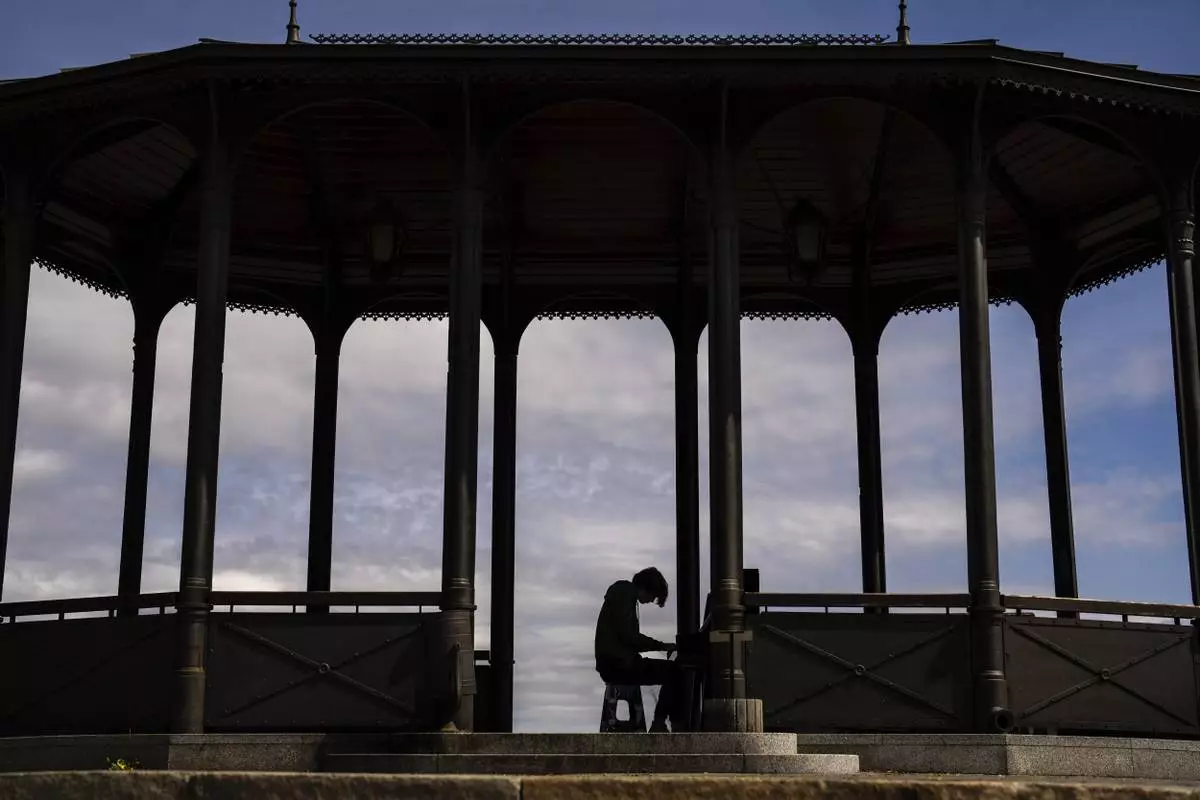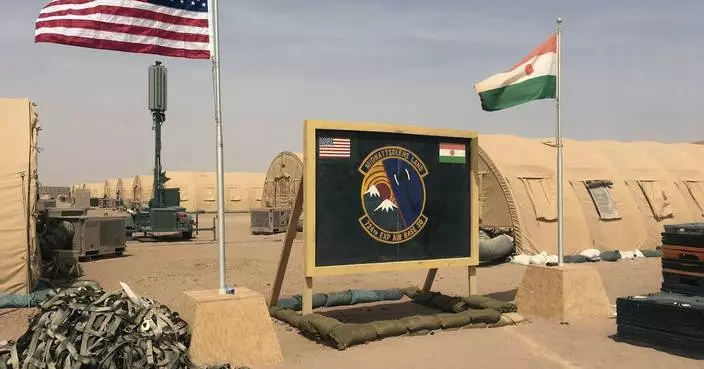The inside of a tank was Clarence Smoyer's home, and the crew was his family.
In that sense, the 95-year-old veteran returned home Wednesday for the first time since World War II. One of the last surviving WWII tank gunners, Smoyer was surprised with a ride through the streets of Boston in a Sherman tank.
Smoyer fought with the U.S. Army's 3rd Armored Division, nicknamed the Spearhead Division. In 1945, he defeated a German Panther tank near the cathedral in Cologne, Germany — a dramatic duel filmed by an Army cameraman that was seen all over the world.
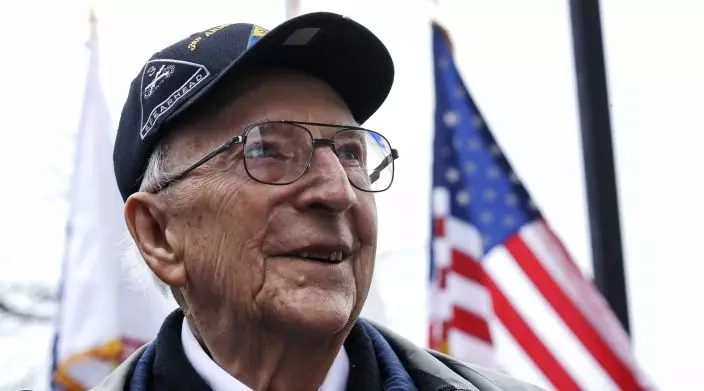
World War II tank gunner Clarence Smoyer smiles as he admires a tank near the Charlestown Naval Shipyard in Boston, Wednesday, Feb. 20, 2019. The 95-year-old veteran was surprised with a ride through the streets of Boston in a Sherman tank, one of the tanks most widely used by the U.S. during the war. (AP PhotoCharles Krupa)
Author Adam Makos tells Smoyer's story in the book "Spearhead," which was released Tuesday. Smoyer would made offhand comments to Makos about how he'd like to get aboard his old Sherman tank one last time. Makos started making calls and Smoyer started doing physical therapy, in case it worked out.
Smoyer, who lives in Allentown, Pennsylvania, had expected a taxi to take him from his hotel to the USS Constitution Museum for a book signing Wednesday. Instead, he found a 32-ton (33 metric ton) Sherman tank from 1944 waiting outside.
A huge smile flashed across Smoyer's face when he walked outside and saw the tank, saying it was a shock to see it.
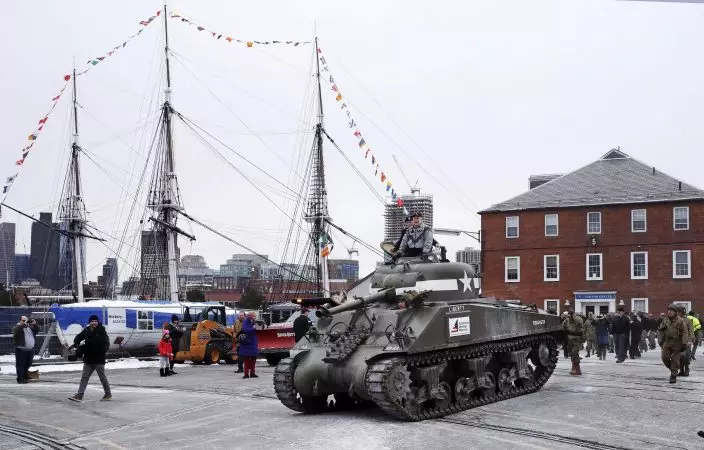
World War II tank gunner Clarence Smoyer sits atop a tank as he passes the historic frigate U.S.S. Constitution at the Charlestown Naval Shipyard in Boston, Wednesday, Feb. 20, 2019. The 95-year-old veteran was surprised with a ride through the streets of Boston in a Sherman tank, one of the tanks most widely used by the U.S. during the war. (AP PhotoCharles Krupa)
"That tank saved my life," he said.
The American Heritage Museum in Hudson, Massachusetts, sent the tank and reenactors representing infantrymen to walk alongside for the short trip to the museum. Service members from the USS Constitution and onlookers came outside to salute Smoyer and the tank as it rolled down the street.
After Smoyer was drafted in 1943, he served on a Sherman tank, first as the person responsible for loading ammunition and later as a gunner.

World War II tank gunner Clarence Smoyer admires a tank near the Charlestown Naval Shipyard in Boston, Wednesday, Feb. 20, 2019. The 95-year-old veteran was surprised with a ride through the streets of Boston in a Sherman tank, one of the tanks most widely used by the U.S. during the war. (AP PhotoCharles Krupa)
Smoyer was such a crack shot that his crew was given one of the Army's state-of-the-art Pershing tanks. That meant they would always go first into battle against German tanks that often were better equipped. Pershing tanks were rushed to Europe after the bloody Battle of the Bulge.
"My tank commander, Bob Earley, used to smoke a pipe and when he'd go for a briefing in the morning, he'd come back and the pipe was jumping in his mouth," Smoyer recalls. "He was nervous because he knew we'd be leading and up in the front again."
Smoyer said he was always scared of rounding a corner and running into the crosshairs of a German tank. He would tell himself to shoot straight and fast before the enemy got his shot in.
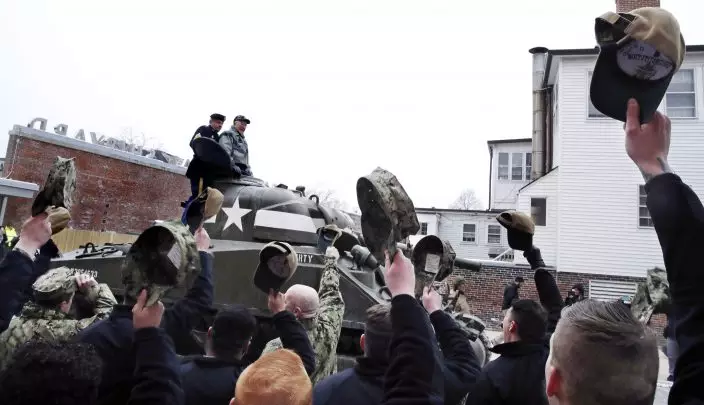
Sailors stationed with the historic frigate U.S.S. Constitution doff their caps as World War II tank gunner Clarence Smoyer enters the Charlestown Naval Shipyard in Boston, Wednesday, Feb. 20, 2019. The 95-year-old veteran was surprised with a ride through the streets of Boston in a Sherman tank, one of the tanks most widely used by the U.S. during the war. (AP PhotoCharles Krupa)
On March 5, 1945, Smoyer heard the company commander say over the radio, "Gentlemen, I give you Cologne. Let's knock the hell out of it." They charged into the city.
Smoyer said he traded fire with a German tank, then shot at a building and toppled it onto the Germans. Eighteen-year-old German tank gunner Gustav Schaefer and his tank commander abandoned their tank and surrendered.
Smoyer advanced and encountered the German Panther by the cathedral. The Panther had just knocked out two American Sherman tanks, killing three men.
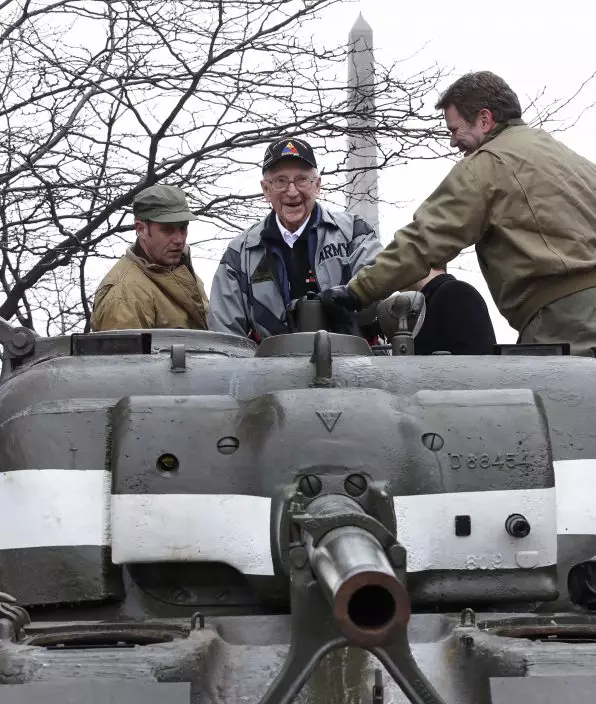
World War II tank gunner Clarence Smoyer smiles as he admires a tank near the Charlestown Naval Shipyard in Boston, Wednesday, Feb. 20, 2019. The 95-year-old veteran was surprised with a ride through the streets of Boston in a Sherman tank, one of the tanks most widely used by the U.S. during the war. (AP PhotoCharles Krupa)
"We pull out into the intersection and the driver saw the tank. We were looking right into the barrel," Smoyer said. "I fired once. Hit them. Sparks were flying. I fired another one, back more toward the engine compartment. I fired the third shot."
Smoyer set the tank on fire so the German crew couldn't fire back. American forces advanced to the Rhine River. Smoyer and his crew were photographed victoriously climbing out of their tank.
Smoyer returned to Pennsylvania in August 1945, married and had three children. He worked at an industrial plant. Few knew that he took out five German tanks during the war.
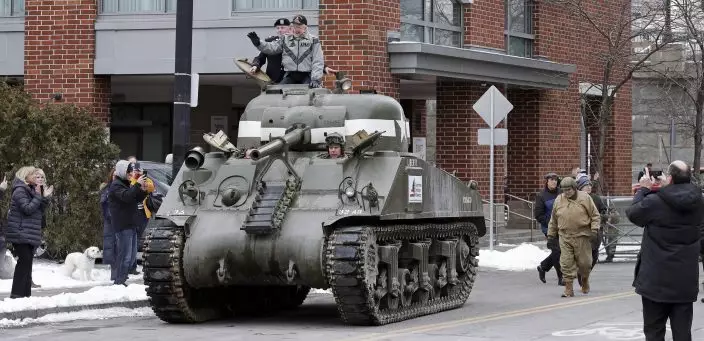
World War II tank gunner Clarence Smoyer waves from his perch seated on the hatch of a tank outside the Charlestown Naval Shipyard in Boston, Wednesday, Feb. 20, 2019. The 95-year-old veteran was surprised with a ride through the streets of Boston in a Sherman tank, one of the tanks most widely used by the U.S. during the war. (AP PhotoCharles Krupa)
Makos met Smoyer through a friend in 2012. In 2013, they traveled to Cologne so Smoyer could meet Schaefer, the German tank gunner.
The two veterans shook hands in front of the cathedral and put roses on the grave of a German woman who was killed in their crossfire. They kept in touch through Christmas cards, letters and Skype until Schaefer died at age 90 in 2017.
"Spearhead" is the story of how their lives collided. Makos organized the surprise tank ride to show his appreciation for Smoyer.
"He did great things for this country and took great risks," Makos said. "Now we're giving him a last salute."
It was a bit of a struggle to get in and out of the tank at his age, Smoyer said — "It used to go a lot better when I was younger" — but it took his breath away to see it.
As for the book, he said, he hopes readers "understand what the fellows went through during the war. War is hell."
"War is hell."



